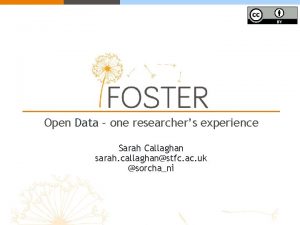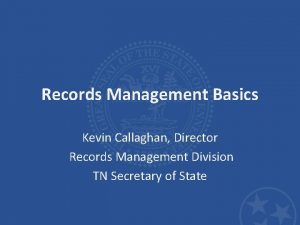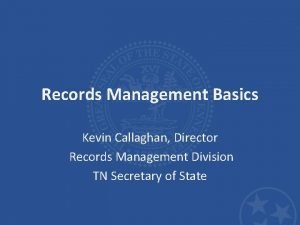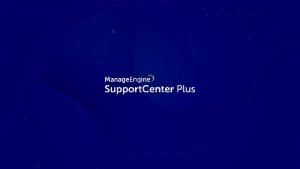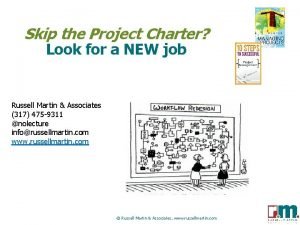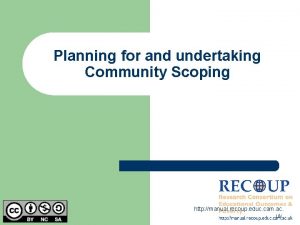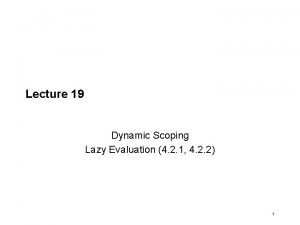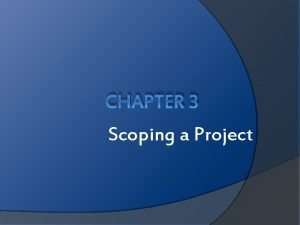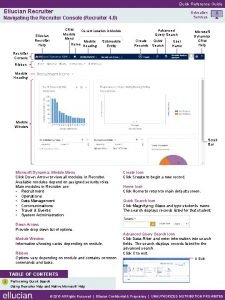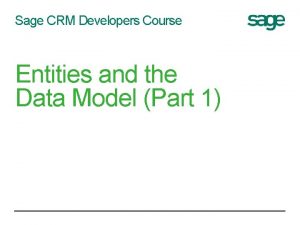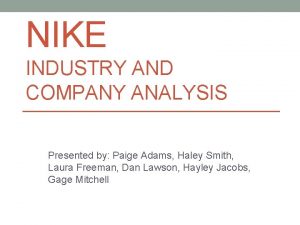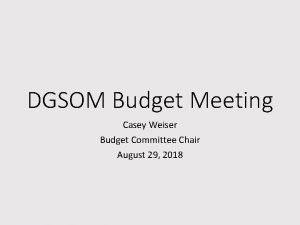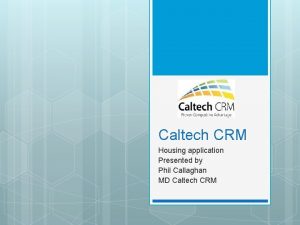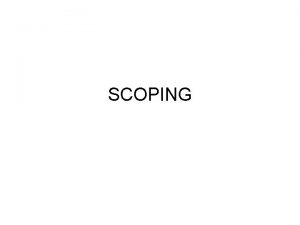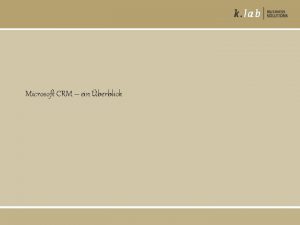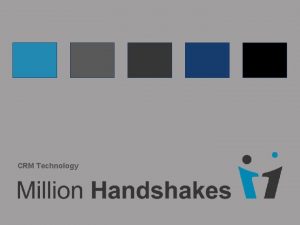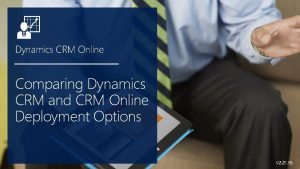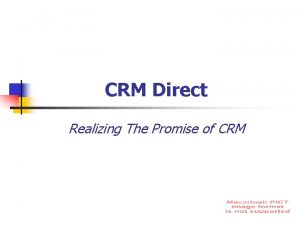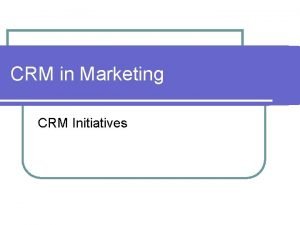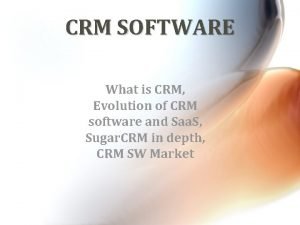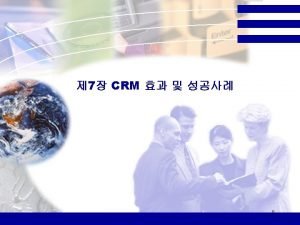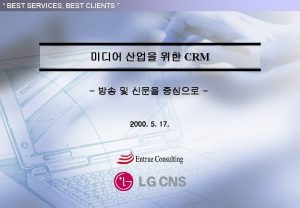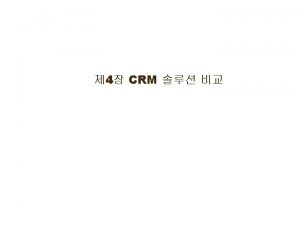Phil Callaghan A Guide to Scoping CRM Scoping













- Slides: 13

Phil Callaghan A Guide to Scoping CRM

Scoping CRM � Scoping a CRM project is daunting but has clear advantages. � A thorough ‘requirements and process review’ will identify the business processes within the project scope. � Carrying out a requirements and process review will generate high value business requirements, and future processes. � Understanding the parameters of your project and clearly communicating this project plan, diminishes the risk. � The risk of a low return on investment, poor user adoption and director level confidence is a reason why CRM projects never get signed off.

1. Understand your Headlines � Your headlines are what has led you to review your CRM systems. What are these headlines? What is giving the business pain? � Task � Document the desired outcomes � Get them agreed at director level � Once the pains and agreed outcomes are agreed don’t lose sight of them. This is the pivotal reason why you are putting the system in place. � Communicate your company-wide goal for implementing CRM

2. Cross Functional Solution � CRM is a cross functional solution. Those involved in the scoping exercise need to be involved at every stage. CRM is used by teams across the company and each department needs to take responsibility for their own part of the system. � Task � Those involved in understanding the headlines, keep them informed. � Identify the champions of the system for each department � Ensure there is a board sponsor

3. Look to the future � Decide what you want a CRM system to do. You will need to consider your current infrastructure, processes, and company-wide key performance indicators. A good CRM solution will fit your evolving needs. � Task � Ensure your champions share their processes and KPIs � Ensure they understand where the processes fail and look at their visionary requirements.

4. Scoping Assessment � Assess your requirements in-depth. Detail the scope. Pull together all your organisations requirements from the headlines to the processes. � Task � Document your scope using the conversations you have had. � Generate a requirements and process review report.

4 a. Useful questions � Sales and Development ◦ How does a prospect contact you to get information about your products and services? ◦ How do you record and track leads? ◦ Is there a sales process that everyone follows? ◦ Do you want to provide quotes through CRM? ◦ What is currently causing problems in the process? ◦ What would you like that you haven’t got now to do your jobs more effectively? ◦ How do you work out on the road? ◦ How involved do you want CRM to be with social networks? ◦ What reporting do you need?

4 b. Useful questions � Marketing ◦ ◦ ◦ ◦ What types of campaigns do you run? What is your time spent on mostly currently? Do you have the data you need to run targeted campaigns? Can you segment data effectively? Do you track return on investment of campaigns? Do you run events? Do you need social media to be more engrained with your CRM solution? ◦ How joined up are you with sales? ◦ Do you carry out email marketing? ◦ How do you manage your supression list

4 c. Useful questions � Customer ◦ ◦ ◦ ◦ Service How are cases or complaints logged? Are there SLA’s or KPI’s that must be adhered to? How do these SLA’s flag? How are the SLA’s reported on? Is there a knowledge base? Are there standard letters? How do customer care communicate – through which methods? ◦ Is there an escalation process? ◦ Do you need scripting or have scripting in place? ◦ How do you allocate a service call?

5. Begin System Research � Always invite a number of CRM experts in and give them your scope as soon as you can. Ensure you consider how user friendly the system is and the potential on-going costs. Consider how cutting edge is the product and what will ensure it doesn’t become obsolete quickly. � Task � Make sure your headlines are at the forefront of the product � Can you work with the system and vendor � Understand the product fully get a trial.

6. Diagnostic � Commission a vendor to supply a diagnostic document. This will cover main areas to be considered to fit your processes and your headlines. This will cover functional areas, current data, documentation, new data, reporting, how you will manage the data and processes, new behaviours to support best practise, integration with existing systems. Task � You will usually pay for a diagnostic document. It will give you clear, high value outcomes of the system capability, outline budgets and analyse the scope. � Ensure the champions are involved in the diagnostic meeting � Caltech offers an impartial voice at this stage and acts as a facilitator �

7. Analysis � An analysis phase is crucial to the success of your CRM implementation. This phase officially starts the implementation project. The analysis phase builds on the diagnostic, and determines the functional requirements. The analysis will cover project planning, risks and issues management, communications management, management of resource and quality, gathering key user training requirements, it will review business requirements and document gaps, build sandbox environments and gather integration and data requirements. Task � Ensure your champions are involved at every stage � The analysis phase is ran as workshops � Acquire your functional requirements document � Ensure there is a clear communication route to your business �

8. Finally � Your CRM implementation is now in safe hands. � Your headlines are at the centre of your requirements and outcomes of the system. � The risk of implementation is minimised. � Planning is key to minimising the risk attached to the investment. � And Beware : of vendors missing out crucial stages – it will only mean pain further down the line or a system that just doesn’t meet your expectations or objectives. Ultimately failing to deliver what it set out to achieve.
